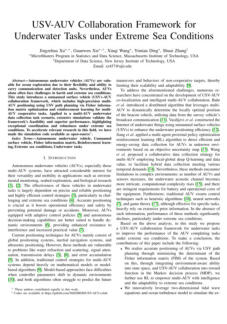Studies of ROV concepts 2024 - Part B










Click on the
octopus to return to
the top of the page

Authors:
Alexander Konoplin, Nikita Krasavin, Alexander Yurmanov,
Pavel Piatavin, Roman Vasilenko, and Maxim Panchuk
This paper describes a new method for controlling
autonomous underwater vehicles (AUVs) equipped with
multilink manipulators, enabling AUVs to perform contact
manipulation operations in a stabilized hovering mode
near or above target objects. It outlines the process of
calculating the force vector needed for the manipulator's
tool to exert the desired force on an object's surface,
generating control signals for additional movements, and
adjusting the AUV's thrusters to maintain the necessary
force. It also discusses compensating for stabilization errors
to ensure continuous contact with the object. The
effectiveness of this system is supported by numerical
modeling and experimental data.

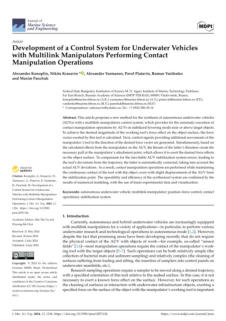

Authors:
Can Wang, Chensheng Cheng, Chun Cao, Xinyu Guo,
Guang Pan and Feihu Zhang
This document discusses the limitations of existing
methods, such as the Extended Kalman Filter (EKF) and
Invariant EKF (IEKF), and proposes an alternative fusion
filtering approach that addresses these limitations to
highlight the innovation and effectiveness of this new
methodology through simulations and real datasets,
emphasizing its robustness and optimization capabilities in
the context of underwater multi-sensor fusion.

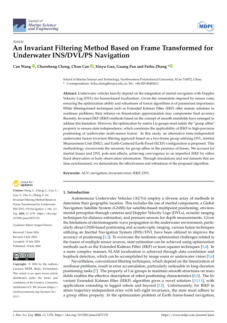

Authors:
Yueming Li, Mingquan Ma, Jian Cao, Guobin Luo,
Depeng Wang and Weiqiang Chen.
This document outlines AUVs' challenges in unknown and
uncertain underwater environments, such as limited
detection capabilities and the inability to obtain real-time
global state information. It explains how multi-agent
reinforcement learning (MARL) is used to improve
autonomous decision-making and collaboration among
AUVs by modeling the search task as a decentralized
partial observation decision process and establishing a
multi-AUV cooperative area search system (MACASS),
allowing AUVs to perform more efficiently in both civilian
and military applications.

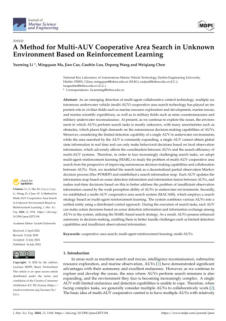

Authors:
Xiaokai Mu, Yuanhang Yi, Zhongben Zhu, Lili Zhu, Zhuo
Wang, and Hongde Qin
This study aims to improve speed estimation accuracy by
utilizing a Self-Attention mechanism with Long Short-Term
Memory (LSTM) to process various input variables. It also
seeks to enhance the model's generalization capability by
incorporating water-track velocity information. It highlights
the effectiveness of this model in comparison to traditional
methods, particularly in scenarios where persistent
bottom-track velocity failures occur, as demonstrated by
sea trial experiments.

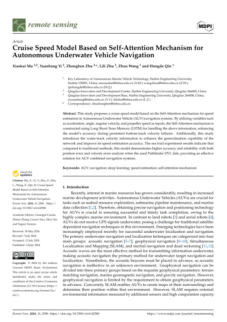

Authors:
Mohammad Afi f Kasno, Izzat Nadzmi Yahaya, and Jin-
Woo Jung
This study highlights the challenges faced by ROV
operators due to the reliance on 2D camera feeds, which
affect orientation awareness and accuracy. It presents a
solution using nine-degrees-of-freedom sensors to capture
real-time orientation data, which is then used to create a
3D model for better visualisation. It also mentions the
constraints of testing due to operator agreements and
presents the effectiveness of the system, noting a low
mean absolute error, indicating its potential as a cost-
effective solution.

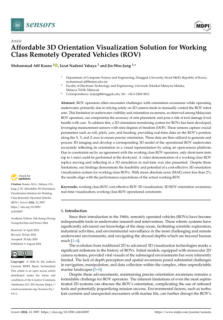

Authors: Patrick Ng, and Michael Krieg
This paper intends to describe the improvements made to
the ArduSub system for the BlueROV2 Heavy, focusing on
enhancing simulation accuracy and autonomous
controller design. It details the implementation and
validation of these improvements, including updates to
the simulation model, replacement of the manual control
algorithm, and the development of a
proportional–derivative (PD) controller within a Robot
Operating System (ROS) to aid augmented reality pilots,
also outlining the testing processes and results.

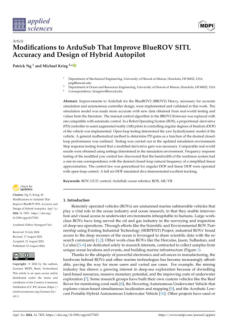

Authors: Guangwu Song , Wei Chen, Qilong Zhou and
Chenkai Guo
This document describes a proposed enhancement to
underwater target identification techniques using an
improved version of the YOLOv8 model. It explains the
modifications made to the model, such as using
deformable convolution and replacing the loss function
with another to improve identification accuracy and
picture quality in underwater environments. This
document also highlights the improved performance
metrics achieved by the enhanced algorithm,
demonstrating its effectiveness for the real-time detection
needs of underwater robots.

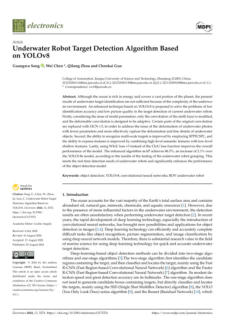

Authors: Hailin Wang, Yiping Li, Shuo Li, and Gaopeng Xu
This study addresses optimizing task allocation for multiple
Autonomous Underwater Vehicles (AUVs) under energy
constraints by conceptualizing it as a Capacitated Vehicle
Routing Problem (CVRP) and using the Solving Constraint
Integer Programs to find effective strategies. It highlights
the significance of this research for marine exploration,
environmental monitoring, and underwater construction
and emphasizes the theoretical and practical contributions
of the study in improving operational efficiency and
mission duration in energy-restricted underwater
environments.

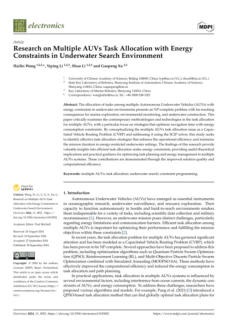

Authors: Xuejiao Yang, Yunxiu Zhang, Rongrong Li, Xinhui
Zheng, and Qifeng Zhang
This paper describes the limitations of current methods,
such as real-time teleoperation and preprogramming. It
introduces a new method using learning from
demonstrations (LfD) and dynamic movement primitives
(DMP) to enhance task reproduction and generalization in
complex underwater environments. The proposed
underwater DMP (UDMP) method aims to address the
challenges posed by the stochastic nature of underwater
environments and improve operational efficiency by
reducing the cognitive burden on operators. It also
mentions using Gaussian mixture models for feature
extraction and the transition from homomorphic to
heteromorphic teleoperation modes.

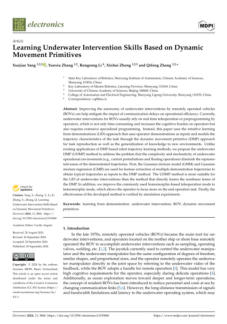

Authors: Huicheol Shin, Sangki Jeong, Seungjae Baek, and
Yujae Song
This study focuses on developing an advanced algorithm
for optimizing energy harvesting and communication
performance in an underwater optical wireless
communication system. That involves a scenario where an
underwater sensor communicates with a remotely
operated vehicle, and the goal is to maximize energy
harvesting at the sensor while maintaining
communication standards. The study also outlines a
hierarchical deep reinforcement learning approach and
deep deterministic policy gradient-based online algorithm
to achieve this objective.

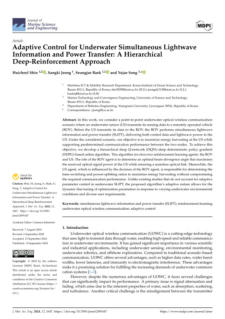

Authors: Gang Sun, Shengtao Chen, Hongkun Zhou, and
Fei Wan
This study analyzes dual floating bodies' interaction
dynamics and hydrodynamic coefficients to optimize
salvage strategies. It discusses specific parameters and
phases of the salvage process, such as the berthing stage,
side-by-side phase, and towing phase, to enhance stability
and efficiency in these operations.

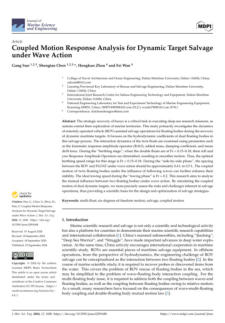

Authors: Lin Zhang, Lianwu Guan, Jianhui Zeng, and
Yanbin Gao
This study aims to address the challenge of improving the
accuracy of navigation data for Autonomous Underwater
Vehicles (AUVs) equipped with Side-Scan Sonar (SSS) used
in seabed mapping. It introduces a post-processing
navigation method using Factor Graph Optimization
(FGO) to enhance the accuracy of AUV trajectories by
integrating various data sources and validating the
method through simulations and experiments.



Authors:
Jaime Alonso Restrepo-Carmona, Elkin A. Taborda,
Esteban Paniagua-García, Carlos A. Escobar, Julián Sierra-
Pérez, and Rafael E. Vásquez
This paper presents a research study that integrates
Systems Engineering (SE) methodologies with Industry
technologies to enhance the design and performance of
underwater robotic systems, specifically focusing on
Remotely Operated Vehicles (ROVs). It aims to
demonstrate how SE can systematically incorporate tools
to improve mission performance and meet stakeholder
expectations using a case study of an underwater
exploration vehicle. It also seeks to address design
challenges and provide a structured methodology for
advancing the design and functionality of complex
systems.

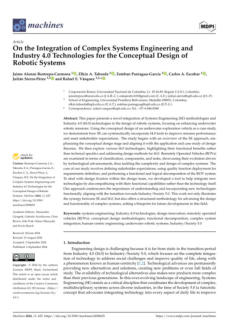

Authors: Soundararajan Vimal Kumar and Jonghoek Kim
This study addresses challenges such as time-varying
delays, model uncertainties, and cyber-attacks that can
affect the performance and stability of AUV systems. It
aims to enhance the robustness of these systems by using
advanced mathematical techniques, including
Lyapunov–Krasovskii functional and linear matrix
inequality, to derive new stability criteria. The research is
positioned as a novel due to its comprehensive approach
to handling multiple complexities simultaneously, and the
effectiveness of the proposed solutions is validated
through examples and simulations.

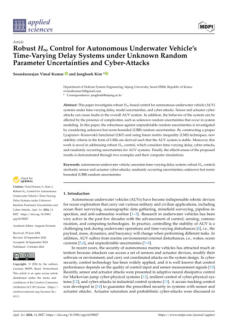

Authors:
Xinglong Feng, Yuzhong Zhang, Ang Gao, and Qiao Hu
This document presents research findings on improving
underwater communication for autonomous underwater
vehicles (AUVs) by addressing issues such as high
attenuation, weak reception signals, and channel
blockage. That involves using a multi-node networking
communication system based on the CSMA/CA protocol,
comparing the performance of OLSR and AODV
protocols, and proposing a dynamic backoff method to
enhance communication reliability and efficiency.

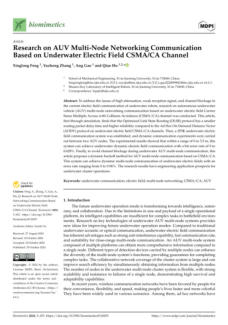

Authors:
Zhiyuan Xu, Yong Shen, Zhexue Xie, and Yihua Liu
This paper is a study on developing and enhancing path-
planning algorithms for Autonomous Underwater
Vehicles (AUVs). It introduces the Field Theory
Augmented algorithm, which integrates field theory
principles with the classical algorithm to address macro-
global and micro-local path planning challenges. It also
highlights the improvements in navigation safety and
efficiency achieved by this algorithm, demonstrating its
practical value for AUV operations in complex marine
environments.

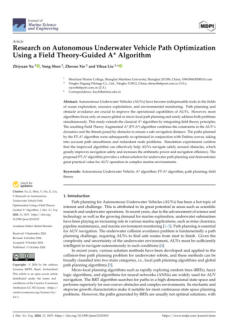

Authors:
Guanghao Yang, Weidong Liu, Le Li, Jingming Xu, Liwei
Guo, and Kang Zhang
This paper explains a new approach for 3D trajectory
tracking in remotely operated vehicles (ROVs) that
combines deep neural networks with event-triggered
nonlinear model predictive control. The text aims to
highlight the advantages of this double closed-loop
control system over traditional single-loop model
predictive control, particularly in terms of handling
external disturbances, reducing computational burden,
and improving tracking performance. Additionally, it seeks
to demonstrate the effectiveness of this method through
simulation results.

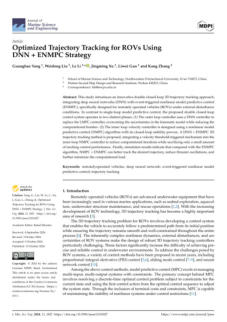

Authors:
Yuliang Wang, Han Bao, Yiping Li, and Hongbin Zhang
This paper describes a technical approach for improving
the control and stability of underactuated Autonomous
Underwater Vehicles (AUVs) in the vertical plane that
outlines the use of mathematical and control theory
methods, such as SO(3) representation, exponential
mapping, interval type II fuzzy systems, backstepping, and
the small gain theorem, to address challenges like Euler
angle singularity, quaternion ambiguity, model changes,
ocean currents, and actuator saturation. It aims to convey
the effectiveness of the proposed controller through
simulation results.

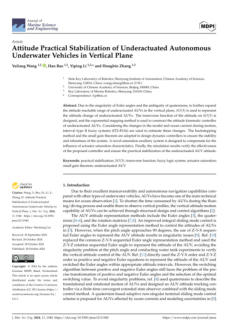

Authors: Fushen Ren and Zhongyang Wang
This document outlines the challenges addressed in the
robot's design, such as modular structure, motion modes,
and control systems, and highlights the use of a sliding
mode control algorithm to enhance the robot's stability
and efficiency underwater. It also compares this algorithm
with a Proportional-Integral-Derivative (PID) control
algorithm, emphasizing the advantages of the sliding
mode control in terms of response speed and stability..

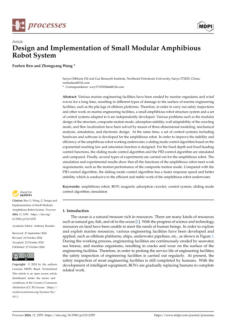

Authors:
Raphaël Garin, Pierre-Jean Bouvet, Beatrice Tomasi,
Philippe Forjonel, and Charles Vanwynsberghe
This paper discusses a novel low-cost algorithm for
simultaneous communication and localization of
autonomous underwater vehicles (AUVs). It outlines the
challenges of AUV navigation due to the limitations of
radio-frequency signals underwater and the absence of
GNSS, proposing a solution that involves using acoustic
signals to estimate the location of an AUV by analyzing
Doppler shift and range data exchanged with a fixed
beacon. It also mentions evaluating this algorithm
through numerical simulations and at-sea experiments.

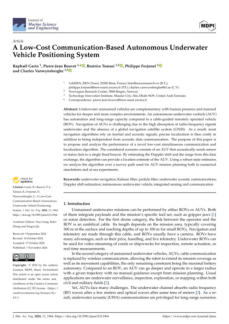



02 - A Method for Multi-AUV Cooperative Area Search in Unknown
Environment Based on Reinforcement Learning.
Authors: Yueming Li, Mingquan Ma, Jian Cao, Guobin
Luo, Depeng Wang and Weiqiang Chen
Multiple autonomous underwater vehicle (multi-AUV)
cooperative area search technology is important for both
civilian and military applications. AUVs face challenges in
unknown environments and limited detection capabilities.
To improve search efficiency, multi-agent reinforcement
learning (MARL) is used, allowing AUVs to make better
decisions by sharing information and using a coordinated
search strategy.
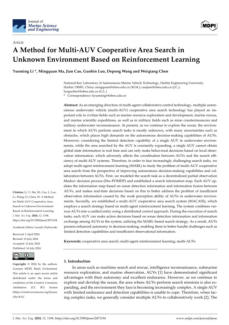



07 - Model Reference Adaptive Control based on Neural Network
for Depth of an AUV.
Authors: Fatima Zohra Kadri, Rachida Ghoul Hadiby,
Kadda Boumediene, Yasmine Derkaoui, Bachir
Daaou, Aicha Djellouli
This study proposes a Model Reference Adaptive Control
(MRAC) using multilayer perceptron neural networks for
controlling the depth of a REMUS AUV amid range
challenges. It aims for adaptive control through
hyperstability applied to a linear vertical AUV model. A
new approach, neural network model reference adaptive
control (NNMRAC), combines classic MRAC with
multilayer perceptron neural networks to enhance
performance. Stability is analyzed using a Lyapunov
function, and the effectiveness of both adaptive control
strategies is evaluated through MATLAB/Simulink,
providing insights on their advantages and limitations.
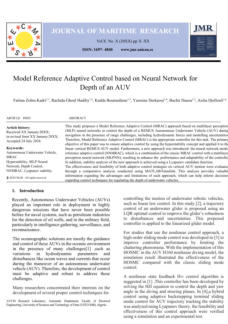



10 - Autonomous Visual Fish Pen Inspections for Estimating the
State of Biofouling Buildup Using ROV - Extended Abstract.
Authors: Matej Fabijanic, Nadir Kapetanovic, & Nikola
Miškovic
The process of fish cage inspections at fish farms can be
fully automated by using autonomous marine vehicles
instead of trained divers. This would reduce costs and
risks. The work proposes a complete solution involving
developing a control algorithm for a remotely operated
vehicle (ROV) and an image processing framework to
estimate biofouling buildup. Experimental results
demonstrate the effectiveness of the system for
autonomous inspections and accurate biofouling
assessments, showing promise for the aquaculture
industry.
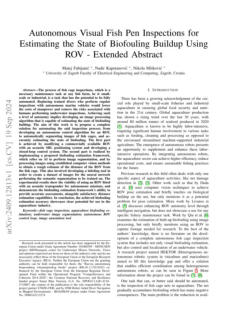



11 - AUV path planning based on improved IFDS and deep
reinforcement learning.
Authors: Fan Yiqun, Li Hongna, Xie Jiaqi, and Zhou
Yunfu
Existing autonomous underwater vehicle (AUV) path
planning algorithms are improving but perform poorly in
real environments due to currents. This paper proposes
an algorithm that combines perturbed flow field and
deep reinforcement learning, improving obstacle
avoidance and adaptability to real environments. The
study compares four algorithms in various scenarios,
showing that the proposed method allows AUVs to plan
paths dynamically in unknown environments.




12 - Modelling of ROV-Operated Disconnectable Mooring Systems
in Wave Dominated Environments.
Authors: Jonathan Glasspool, Francesco Giorgio-Serchi,
Ajit C. Pillai
Existing autonomous underwater vehicle (AUV) path
planning algorithms are improving but perform poorly in
real environments due to currents. This paper proposes an
algorithm that combines perturbed flow field and deep
reinforcement learning, improving obstacle avoidance
and adaptability to real environments. The study
compares four algorithms in various scenarios, showing
that the proposed method allows AUVs to plan paths
dynamically in unknown environments.
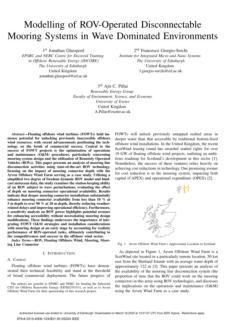



19 - Quantitative Comparison of ROV and Diver-Based
Photogrammetry to Reconstruct Maerl Bed Ecosystems.
Authors: Ona L. R. Paterson, Kathryn E. Dawson,
Andrew O. M. Mogg, Martin D. J. Sayer,
Heidi L. Burdett
Floating offshore wind turbines (FOWTs) have great
potential for offshore wind resources. This paper analyzes
mooring line disconnection using ROV technology,
focusing on mooring connector depth at Arven Offshore
Wind Farm. Results show deeper installations improve
connector availability, enhancing operational efficiency.
The study highlights the need to integrate O&M strategies
with early mooring design considerations.




20 - Comparison of a tower geodetic micro-network optimization
results obtained using the MABAC, MAIRCA, COCOSO and
ROV methods with those obtained applying the VIKOR method.

Author: Darko Andie
In this study, the author optimizes a tower geodetic micro-
network using the MABAC (Multi-Attributive Border
Approximation Area Comparison), MAIRCA (Multi-
Attributive Ideal-Real Comparative Analysis), COCOSO
(Combined Compromise Solution), and ROV methods.
These methods were compared with the VIKOR
(VIseKriterijumska Optimizacija I Kompromisno Resenje)
method, developed to solve multi-criteria decision-making
problems, which is proven effective. Criteria for precision
and reliability were established, and four acceptable
network solutions were ranked.
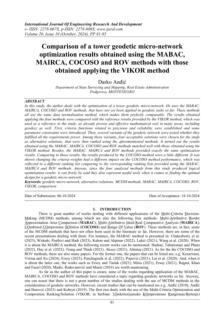

Authors: Nikolaos Manos, Ergina Kavallieratou, Nikos
Vasilopoulos
Kalypso is a 3D-printed underwater robot designed to
improve aquaculture management in the Mediterranean
Sea for species like sea bream and catfish. It operates in
two modes: autonomously for inspections and remotely
for complex tasks. It helps detect problems and allows
direct intervention. Kalypso enhances maintenance, fish
welfare, and resource use, making it a valuable tool for
Mediterranean fish farms.


31 - Kalypso: An inspection AUV for aquaculture.



33 - USV-AUV Collaboration Framework for Underwater Tasks
under Extreme Sea Conditions.
Authors: Jingzehua Xu, Guanwen Xie, Xinqi Wang,
Yimian Ding, Shuai Zhang
Autonomous underwater vehicles (AUVs) are useful for
exploring oceans but struggle in tough sea conditions.
This study presents a framework for AUV and unmanned
surface vehicle (USV) collaboration, improving multi-AUV
positioning and coordination. Extensive simulations
confirm the framework's effectiveness in extreme
conditions, and the simulation code is open-source.



28 - A Hierarchical Planning Method for AUV Search Tasks Based on
the Snake Optimization Algorithm.
Authors: Zhiwen Wen, Zhong Wang, Xiangdong Wen,
Chenxi Niu, Pei Wang, and Daming Zhou
In a complex battlefield, enabling autonomous
underwater vehicles (AUVs) to quickly reach dynamic
targets is crucial for search tasks. This study proposes a
hierarchical AUV task planning method combining
hierarchical programming and a snake optimization
algorithm. The method includes three planning levels
focused on minimizing encounter and navigation times
while optimizing trajectories. Simulation experiments
verified its effectiveness, demonstrating that it can plan
AUV searches efficiently. This method holds practical
significance for similar underwater task planning issues.
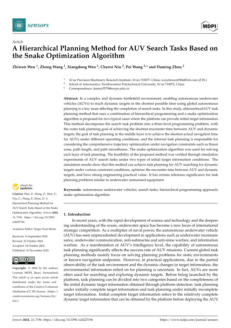



29 - Design and Computational Modelling of AUV Tunnel Thruster
Covers for Effi cient Operation
Authors: Christopher McNeill, Zachary Cooper-Baldock,
and Karl Sammut
Autonomous underwater vehicles are widely used for
mapping, surveillance, and inspections. Hovering AUVs
have limited energy due to their design, requiring efficient
hydrodynamic designs. This work suggests adding a
retractable thruster cover to improve propulsion efficiency.
A comparison shows that this cover reduces drag by 9.
51%, which enhances the AUV's operational efficiency,
making it suitable for energy-limited vehicles.
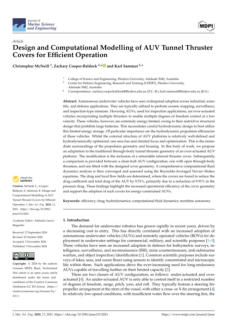



30 - Allocation Strategy Optimization Using Repulsion-Enhanced
Quantum Particle Swarm Optimization for Multi-AUV Systems.
Authors: Changjian Lin, Dan Yu, and Shibo Lin
In multi-autonomous underwater vehicle (multi-AUV)
operations, target assignment is a multi-objective
allocation problem. Strategy selection depends on the
non-cooperative environment. This paper creates a system
to evaluate this environment and develops a target
allocation model using bi-matrix game theory. The model
includes a payoff matrix based on various factors. A
simulation experiment validates the model and shows the
effectiveness of the repulsion process quantum particle
swarm optimization (RPQPSO) algorithm in multi-AUV
scenarios.
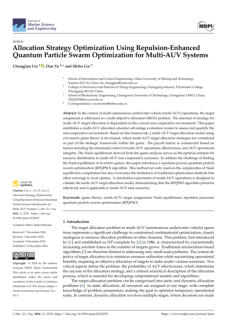
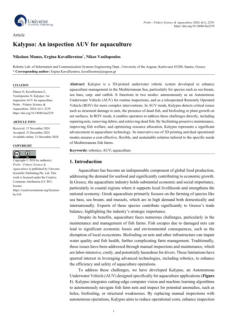

Authors: Jefferson Osowsky, Tin Muskardin, Leonardo M.
Barreira
This work presents a project to convert a commercial
Remote Operated Vehicle (ROV) into a Remotely Piloted
ROV using two approaches. The first approach developed
a serial/ethernet converter with an ESP32 microcontroller
to transfer data between the hand controller and the
ROV control console. The second approach replaced the
ROV remote control with a Single Board Computer (SBC)
to emulate the remote control signals. The development
and results of these methods will be presented.


32 - Remote Piloting Development of an ROV

